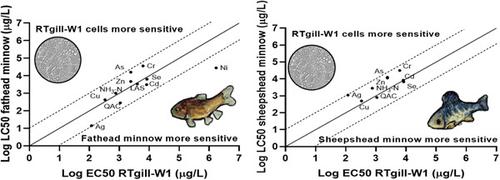当前位置:
X-MOL 学术
›
Environ. Toxicol. Chem.
›
论文详情
Our official English website, www.x-mol.net, welcomes your feedback! (Note: you will need to create a separate account there.)
Applications of the RTgill‐W1 Cell Line for Acute Whole‐Effluent Toxicity Testing: In Vitro–In Vivo Correlation and Optimization of Exposure Conditions
Environmental Toxicology and Chemistry ( IF 4.1 ) Pub Date : 2020-11-30 , DOI: 10.1002/etc.4947 Justin Scott 1 , Jason B Belden 1 , Matteo Minghetti 1
Environmental Toxicology and Chemistry ( IF 4.1 ) Pub Date : 2020-11-30 , DOI: 10.1002/etc.4947 Justin Scott 1 , Jason B Belden 1 , Matteo Minghetti 1
Affiliation

|
The cell line RTgill‐W1 was evaluated as an in vitro alternative model for acute fish whole‐effluent toxicity (WET) testing. We determined the 50% effective concentration (EC50) that reduces the viability of RTgill‐W1 cells for selected toxicants commonly found in effluent samples and correlated those values with the respective 50% lethal concentration (LC50) of freshwater (fathead minnow, Pimephales promelas) and marine (sheepshead minnow, Cyprinodon variegatus) fish species obtained from the literature. Excluding low water‐soluble organics and the volatile sodium hypochlorite, significant correlations were measured for metal, metalloids, ammonia, and higher water‐soluble organics between in vitro EC50 values and in vivo LC50 values for both species. Typically, toxicity studies with RTgill‐W1 cells are conducted by adding salts to the exposure medium, which may affect the bioavailability of toxicants. Osmotic tolerance of RTgill‐W1 cells was found between 150 and 450 mOsm/kg, which were set as the hypoosmotic and hyperosmotic limits. A subset of the toxicants were then reexamined in hypoosmotic and hyperosmotic media. Copper toxicity decreased in hyperosmotic medium, and nickel toxicity increased in hypoosmotic and hyperosmotic media. Linear alkylbenzene sulfonate toxicity was not affected by the medium osmolality. Overall, RTgill‐W1 cells have shown potential for applications in measuring metal, metalloids, ammonia, and water‐soluble organic chemicals in acute WET tests, as well as complementing current toxicity identification and reduction evaluation strategies. In the present study, RTgill‐W1 cells have been established as a valid animal alternative for WET testing, and we show that through manipulation of medium osmotic ranges, sensitivity to nickel was enhanced. Environ Toxicol Chem 2021;40:1050–1061. © 2020 SETAC
中文翻译:

RTgill-W1 细胞系在急性全流出物毒性测试中的应用:体外-体内相关性和暴露条件的优化
细胞系 RTgill-W1 被评估为用于急性鱼类全排放毒性 (WET) 测试的体外替代模型。我们确定了降低 RTgill - W1 细胞活力的 50% 有效浓度 (EC50) 对废水样品中常见的选定毒物,并将这些值与淡水(黑头鲦鱼、Pimephales)各自的 50% 致死浓度 (LC50) 相关联promelas ) 和海洋 (羊头鲦鱼, Cyprinodon variegatus) 从文献中获得的鱼种。排除低水溶性有机物和挥发性次氯酸钠,两种物种的体外 EC50 值和体内 LC50 值之间的金属、准金属、氨和较高水溶性有机物的相关性显着。通常,RTgill ‐W1 细胞的毒性研究是通过在暴露介质中添加盐来进行的,这可能会影响毒物的生物利用度。RTgill ‐W1 细胞的渗透耐受性在 150 和 450 mOsm/kg 之间,这被设置为低渗和高渗极限。然后在低渗和高渗介质中重新检查了一部分毒物。铜毒性在高渗介质中降低,而镍毒性在低渗和高渗介质中增加。线性烷基苯磺酸盐的毒性不受介质渗透压的影响。总体而言,RTgill ‐W1 细胞已显示出在急性 WET 测试中测量金属、准金属、氨和水溶性有机化学物质的应用潜力,以及补充当前的毒性识别和减少评估策略。在本研究中,RTgill ‐W1 细胞已被确定为 WET 测试的有效动物替代品,我们表明,通过控制中等渗透范围,提高了对镍的敏感性。环境毒理学化学2021;40:1050-1061。© 2020 SETAC
更新日期:2020-11-30
中文翻译:

RTgill-W1 细胞系在急性全流出物毒性测试中的应用:体外-体内相关性和暴露条件的优化
细胞系 RTgill-W1 被评估为用于急性鱼类全排放毒性 (WET) 测试的体外替代模型。我们确定了降低 RTgill - W1 细胞活力的 50% 有效浓度 (EC50) 对废水样品中常见的选定毒物,并将这些值与淡水(黑头鲦鱼、Pimephales)各自的 50% 致死浓度 (LC50) 相关联promelas ) 和海洋 (羊头鲦鱼, Cyprinodon variegatus) 从文献中获得的鱼种。排除低水溶性有机物和挥发性次氯酸钠,两种物种的体外 EC50 值和体内 LC50 值之间的金属、准金属、氨和较高水溶性有机物的相关性显着。通常,RTgill ‐W1 细胞的毒性研究是通过在暴露介质中添加盐来进行的,这可能会影响毒物的生物利用度。RTgill ‐W1 细胞的渗透耐受性在 150 和 450 mOsm/kg 之间,这被设置为低渗和高渗极限。然后在低渗和高渗介质中重新检查了一部分毒物。铜毒性在高渗介质中降低,而镍毒性在低渗和高渗介质中增加。线性烷基苯磺酸盐的毒性不受介质渗透压的影响。总体而言,RTgill ‐W1 细胞已显示出在急性 WET 测试中测量金属、准金属、氨和水溶性有机化学物质的应用潜力,以及补充当前的毒性识别和减少评估策略。在本研究中,RTgill ‐W1 细胞已被确定为 WET 测试的有效动物替代品,我们表明,通过控制中等渗透范围,提高了对镍的敏感性。环境毒理学化学2021;40:1050-1061。© 2020 SETAC



























 京公网安备 11010802027423号
京公网安备 11010802027423号